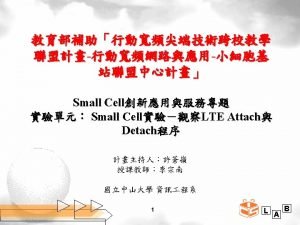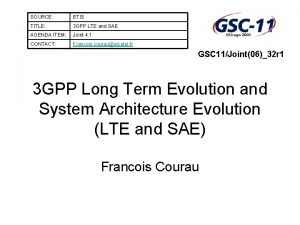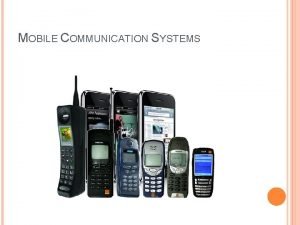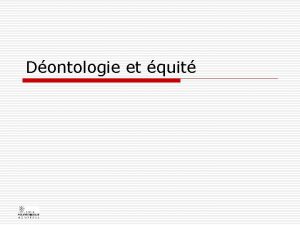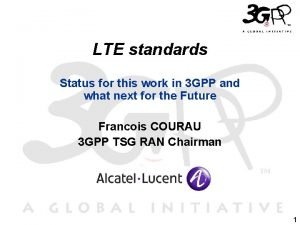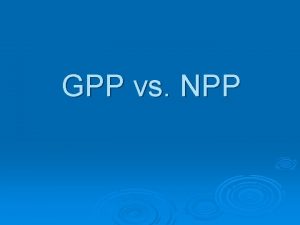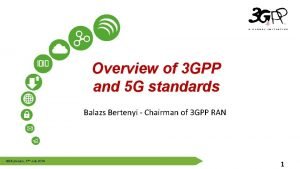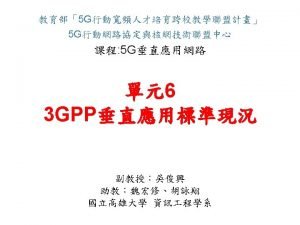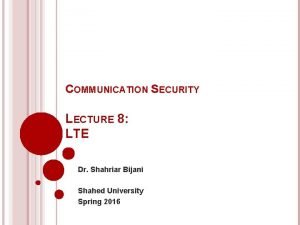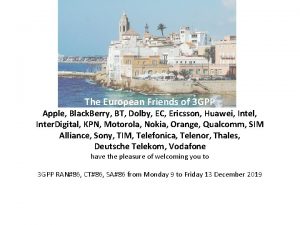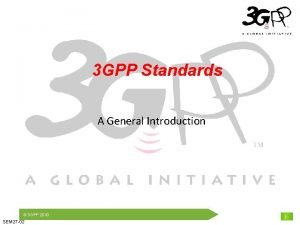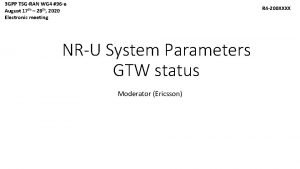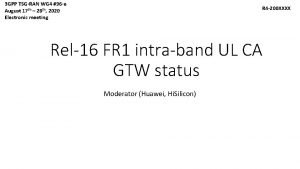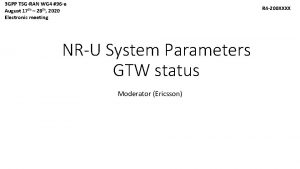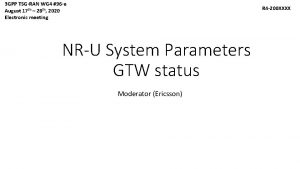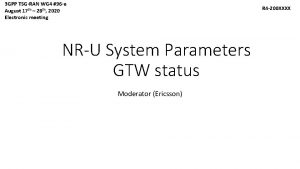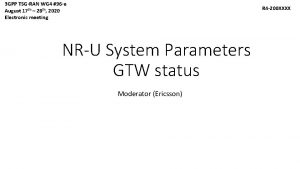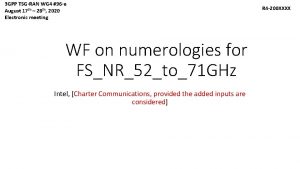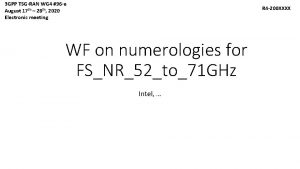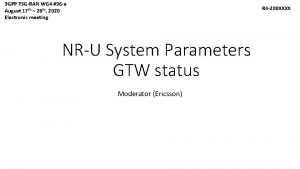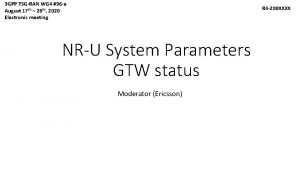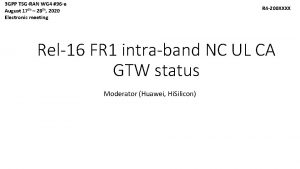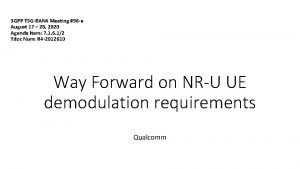3 GPP TSGRAN WG 4 96 e August














- Slides: 14

3 GPP TSG-RAN WG 4 #96 -e August 17 th – 28 th, 2020 Electronic meeting R 4 -200 XXXX NR-U System Parameters GTW status Moderator (Ericsson)

Background There are three major topics under discussion: • Topic #1: Introduction of 6 GHz band considering band plan and channelization • Topic #2: System parameters considering 100 MHz CBW in NR-U Rel 16 and Spectrum Utilization • Topic #3: Wideband capabilities

Introduction of 6 GHz band Issue 1 -1: 6 GHz Band plan Proposals • Option 1: Consider following bands for 6 GHz: • Standard-power operation: Band x: 5925 - 6425 MHz, Band z: 6525 - 6875 MHz • Indoor operation: Band y: 5925 - 7125 MHz • Option 2: To include band n 96 for NR-U with 5925 – 7125 MHz range. • Option 3: First specify the requirements then define the band plan • Status : • Option 1: 4 companies: Huawei, BT, DT • Option 2: 9 companies: QC, Charter, SKW, Nokia, LG, Apple, Verizon, AT&T, Qorvo • Option 3: 3 companies: ZTE, Media. Tek, CHTTL Agreements: • Agreed on 5925 – 7125 MHz range as the band plan, assuming all the requirements including system parameters and the UE and BS requirements can be completed at this meeting. If not completed, the band plan will be further discussed in future RAN 4/RAN meetings. • This band is intended for operations subject to FCC NPRM RNO (needs to be clearly specified in the specifications) • It does not preclude specification of other bands or use of other bands in the same frequency range in other regions

NR-U System parameters Issue 2 -1 -1: 100 MHz channel bandwidth Proposals • Option 1: Define 100 MHz channel bandwidth for NR-U in 5 GHz (Huawei) • Option 2: Do not define 100 MHz channel bandwidth for NR-U in 5 GHz (n 46) in Release 16 (Charter) • Status : • Option 1 : 2 companies • Option 2 : 8 companies • Tentative agreement: • Option 2

Introduction of 6 GHz band Issue 1 -3: AFC functionality and coexistence with ITS • Define AFC functionality for NR-U operation • Study coexistence between NR-U operation in 6 GHz and ITS in band n 47 Proposals • Agreeable • Not agreeable • Status : • Agreeable: 4 companies • Not agreeable: 8 companies • Tentative Agreement: • Not agreeable, AFC is out of scope of 3 GPP, Coexistence with ITS is already considered in the regulatory fora.

Response to RAN 1 LS Question 1: Is there any difference in DL reception among DL Cases 1, 2 a, 2 b, 2, and 3 with respect to AGC when at least one of the sub-bands of a [BW or carrier] is not part of g. NB’s acquired channel occupancy and contains interference from devices other than the UE’s serving g. NB e. g. near-by Wi. Fi AP? Does RAN 4 think AGC issues may prevent UE to meet RAN 4 requirements for Mode 2 and Mode 3? Tentative response: Same AGC dynamic range will be shared by all WB operation cases. Performance degradation can happen if the subband is occupied by a near-by Wi. Fi for Case 2 a/2 b/3/4. RAN 4 will not define corresponding RF requirements for RF filters nor RRM requirements for filter adaptation for Case 2 a/2 b/3/4 in Rel-16. Question for clarification: Why to consider Case 4 together with Case 2 a/2 b/3 in the response Case 4: Case 2 a: • • Blocker No data on intra-cell GB Contiguous sub-bands CC#1 Case 2 b: • • No data on intra-cell GB Non-Contiguous sub-bands Blocker CC#1 Case 3: • • Data on intra-cell GB Contiguous sub-bands Blocker CC#1 Time axis 1. UE configuration: one CC with 3 subbands CC#1 2. g. NB decides to schedule only a subset of subbands CC#1 3. Later the un-used subband is occupied by Wi. Fi Blocker CC#1

Response to RAN 1 LS Question 2 a: Is there a difference in UE capability between any of DL Cases 2 a/2 b and DL Case 3? Tentative response: Yes, as indicated by the UE feature 4 -2. If 4 -2 is supported, means the UE could support Case 3, otherwise, UE support Case 2 a/2 b Question for clarification: Whether UE capabilities are needed for Case 2 a/2 b/3 • Option 1: Case 2 a/2 b/3 are not considered In Rel-16 due to lack of requirement. (Media. Tek) • Option 2: Introduce UE capability with a note that the corresponding requirements are not defined in Rel-16. • Option 3: Introduce UE capability. (Huawei) • Option 4: No additional capabilities. Case 2 a/2 b should be part of Case 1 (intra-band CA) and Case 3 difference to Case 2 a/2 b is the capability of scheduling GB. (Nokia) Case 2 a: • • Case 3: No data on intra-cell GB Contiguous sub-bands CC#1 Case 2 b: • • No data on intra-cell GB Non-Contiguous sub-bands • • Data on intra-cell GB Contiguous sub-bands CC#1 Case 4: • CC#1 Single carrier WB CC#1

Response to RAN 1 LS Question 2 b: Is there a difference in UE capability between any of DL Cases 2 a/2 b/3 and DL Case 4? Tentative response: Yes. DL Case 4 is mandatory. Question for clarification: same as previous question Case 2 a: • • Case 3: No data on intra-cell GB Contiguous sub-bands CC#1 Case 2 b: • • No data on intra-cell GB Non-Contiguous sub-bands • • Data on intra-cell GB Contiguous sub-bands CC#1 Case 4: • CC#1 Single carrier WB CC#1

Response to RAN 1 LS Question 2 c: Is there a difference in UE capability between any of DL Cases 2 a/2 b/3/4 and DL Case 1? Tentative response: Yes. DL WB operation Case 1(CA) is an independent UE capability

Response to RAN 1 LS Question 3: From RAN 4 point of view, does “all LBT sub-bands” for Mode 1 refer to LBT sub-bands of configured carrier or BWP? Tentative response: Current NR considers requirements related to the carrier and not the BWP. RAN 4 are of the understanding that it shall be all LBT sub-bands per configured carrier for both UL and DL

Response to RAN 1 LS Question 4: Is change of transmit filtering required (as shown in Figure 1 for WB Mode 2 B) to meet RAN 4 requirements for any of UL Cases 1 -3? Tentative response: No for all cases Question for clarification: Is it the correct understanding that UE can achieve the requirement in 6. 5 F. 2. 2. 1 without filter adaptation? I. e. , UE was configured with a WB carrier with 60 MHz. Therefore the filter setting was targeting to fulfil the 60 MHz requirement. But later UE is scheduled with only 1 subbands. Even in this case, UE still does not need to adapts its RF filter to fulfil the 20 MHz requirement 6. 5 F. 2. 2. 1 Spectrum emission mask for non-transmitted channels In the case of non-transmitted 20 MHz channel(s) on the edges of an assigned channel bandwidth the spectrum emission mask for operation with shared spectrum channel access, specified in Table 6. 5 F. 2. 2 -1, is applied by using the total bandwidth of the remaining transmitted channels. The spectrum emission mask for non-transmitted channels is floored at -28 d. Br.

Response to RAN 1 LS Question 5: Is there any difference if intra-cell GBs between scheduled contiguous sub-bands are scheduled or not? Tentative response: There is no difference in RF requirement if intra-cell GBs between scheduled contiguous sub-bands are scheduled or not. RAN 4 removed capability for UE transmission in UL intra-cell GBs. The intra-cell GB between two scheduled adjacent RB-sets shall be scheduled

Introduction of 6 GHz band Issue 1 -2: Channelization Proposals • Option 1: Do not reuse the same channel allocation as 802. 11 ax. Revised channelization on top of 802. 11 ax should be considered for 6 GHz band in NRU. • Option 2: Adopt the following proposals: • It is proposed to introduce at least 20 MHz, 40 MHz, 60 MHZ, and 80 MHz channel bandwidths for NR-U band in 6 GHz unlicensed band. • It is proposed to align channel raster for NR-U in band n 96 with Wi-Fi channels in 6 GHz. • It is proposed to set 60 MHz channels only within 80 MHz channel i. e. to adopt channel bonding rule for 60 MHz CBW. • It is proposed to introduce 15 k. Hz as global frequency raster for band n 96 and NREF numbers for respective CBW as in table 1 in R 4 -2010744. • It is proposed to introduce band n 46 principles for synchronization raster for band n 96 and GSCN numbers for respective CBW as in table 2, R 4 -2010744. • Status : • Option 1: 4 companies • Option 2: 7 companies • Agreements: • TBD

NR-U System parameters Issue 2 -2: Spectrum Utilization Proposals • Option 1: • 25 PRB for 20 MHZ channel bandwidth should be mandatory for a UE supporting 60 k. Hz SCS. • 25 PRBs for 60 k. Hz intra-carrier guard bands should be supported. • Option 2 : • 24 RBs for 20 MHz channel with 5 RBs for in-carrier guard band • Status : • Option 1 : 3 companies • Option 2 : 4 companies • Agreements: • TBD
